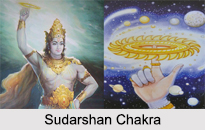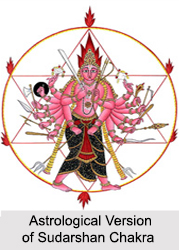 Sudarshana Chakra is a spinning, disk-like weapon with 108 serrated edges used by the Hindu God Vishnu. In mythology, Sudarshana Chakra is described as the most powerful weapon of the universe. It has the ability to travel several million kilometres at a blink of an eye.
Sudarshana Chakra is a spinning, disk-like weapon with 108 serrated edges used by the Hindu God Vishnu. In mythology, Sudarshana Chakra is described as the most powerful weapon of the universe. It has the ability to travel several million kilometres at a blink of an eye.
Etymology of Sudarshana Chakra
The word Sudarshan Chakra is derived from two words, "su" and "darshan". It means the vision (Darshan) which is favourable (Su). The word chakra is derived from "chruhu", which means movement and "kruhu", which means to do. Thus, "chakra" means something which is movable.
Legends of Sudarshana Chakra
Sudarshana Chakra may be depicted as an "ayudhapurusha". In many South Indian Vishnu temples, it is as an "ayudhapurusha" which is worshipped in its own shrine attached to the central temple. According to the Hindu Puranas, Sudarshana Chakra is used for the ultimate destruction of an enemy. The depiction of Lord Vishnu with Sudarshana Chakra also means that Lord Vishnu is the keeper-owner of the celestial bodies and heavens.
Sudarshana Chakra was made by the architect of Gods, Lord Vishvakarma. Vishvakarma`s daughter Sanjana was married to Lord Surya, the Sun God. Due to the Sun`s blazing light and heat, she was unable to go near the Sun. She complained to her father about this. Vishvakarma took the Sun and made him shine less so that his daughter would be able to hug the Sun. The left over Sun "dust" was collected by Vishvakarma and made into three divine objects. The first one was the aerial vehicle Pushpaka Vimana, the second being the Trident of the God Lord Shiva or Mahadeva, and the third was the Sudarshana Chakra of Lord Vishnu. The Chakra is described to have 10 million spikes in two rows moving in opposite directions to give it a serrated edge.
 Sudarshana Chakra was used to cut the corpse of Sati, the consort of Lord Shiva into 51 pieces after she gave up her life by throwing herself in a "yagna" (fire sacrifice) of her father Daksha. It is said that Lord Shiva, in grief, carried around her lifeless body and was inconsolable. The 51 parts of the goddess` body were then tossed about in different parts of the Indian subcontinent and came to be known as "Shakti Peethas".
Sudarshana Chakra was used to cut the corpse of Sati, the consort of Lord Shiva into 51 pieces after she gave up her life by throwing herself in a "yagna" (fire sacrifice) of her father Daksha. It is said that Lord Shiva, in grief, carried around her lifeless body and was inconsolable. The 51 parts of the goddess` body were then tossed about in different parts of the Indian subcontinent and came to be known as "Shakti Peethas".
The use of the Sudarshan Chakra is occasionally mentioned in the Hindu texts of Rig Veda, Yajur Veda and Puranas, as an ultimate weapon of law, order and preservation to eliminate the enemy. Such enemies are enumerated variously as "rakshasas", "asura", and "vikrutatma". In one such instance, as scribed in the stanzas of the Mahabharata, Lord Krishna, the Avatar of Lord Vishnu, beheads Shishupala with the use of the Sudarshan Chakra, for his rapacious behaviour (committing 100 mistakes each worthy of death) at the Rajsuya yagna celebration of Emperor Yudhishthira. It was also used to cut the celestial mountain Mandrachal Parvat for churning the ocean of milk (Samudra Manthan).
In Tamil, Sudarshana Chakra is also known as Chakkrath Azhwar (translated as Ring of God). The Chakri Dynasty, the present ruling house of Thailand, is named after this weapon.
Parts of Sudarshan Chakra
The middle stable part is named "bhruvi" (equality), "bhag" (radiance), "nirdesh" (speed) and "sampada" (endowed with the nectar of nutrition). The spokes has twenty-seven spokes charged with the run energy of the twenty-seven feminine principles created from Prajapati. "Yogini" means the one who presents the energy which is unachievable. "Narayani" is pervading. "Murdha" is the linear part included in the longitudinal section between the centre of the eyebrows and the column. "Randhra" is the speed or energy.
Parigh part is constituted by the following eight masculine principles, they are as follows:
•Aditya
•Varuni
•Juhu
•Indra
•Narayan
•Navadha
•Gandhi
•Mahish
Sudarshan Chakra is not thrown at anybody, rather, by willpower, it is sent against the enemy.




















